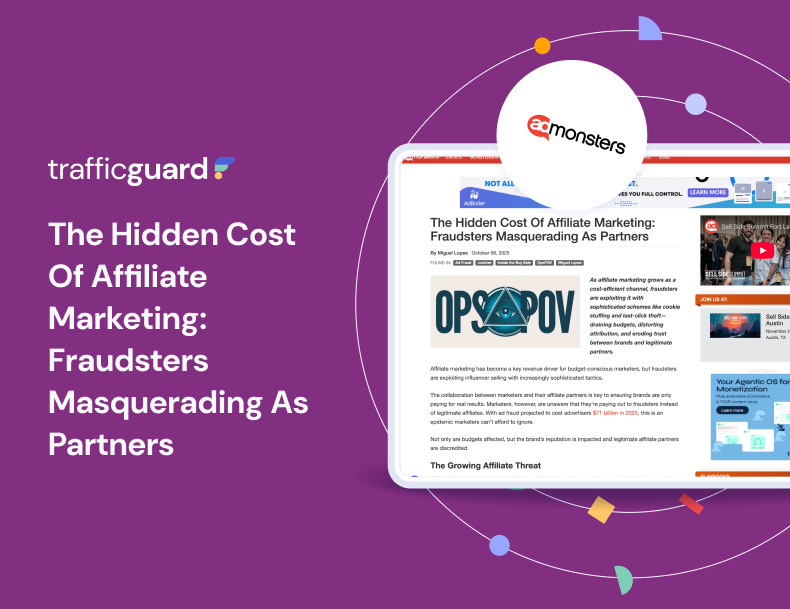Ad tech across APAC is a complex, fast-growing industry. What does its future hold?

This article was written by TrafficGuard Founder and Chief Operating Officer, Luke Taylor, for Anthill Magazine.
With digital penetration reaching 52% across the Asia Pacific region and growing according to a report by We Are Social and Hootsuite, it’s no surprise that businesses are prioritising their advertising dollars in digital campaigns. Indeed, a recent study by Dentsu Aegis Network estimates that in 2019, digital advertising will account for almost 50% of ad spend in Asia Pacific alone, growing 4.5% to take the total investment to US$220 billion.
Digital advertising – and the ad tech that supports it – has in fact completely revolutionised the way that brands connect and communicate with potential customers.
The digital advertising ecosystem is made up of layers with each layer in the stack delivering additional value, helping businesses to optimise conversations with intended audiences. From the way brands convey their messages, identify and test target audiences, tailor and scale digital campaigns, manage data and channels, and analyse the results – different tech platforms drive incremental value that adds up to substantial value for businesses advertising. Simply put, ad tech solutions help businesses cut through the clutter, to enable efficient delivery of digital advertising campaigns, while also helping digital publishers and apps, monetise their audiences.
But with many layers also comes complexity. So what’s the outlook for ad tech in the region, and what should businesses be aware of to make the most of digital investments?
A glimpse into the future of advertising
As technologies evolve and new opportunities emerge, digital advertising only becomes more powerful. For example, with 5G connectivity, users will experience faster download speeds, consumer drop-offs due to slow site loading will decrease, and brands will be able to create more engaging campaigns in interactive formats.
For example, Burger King recently ran a marketing campaign harnessing the power of AR, where it encouraged users to “burn” competitor banner ads in exchange for a discount on their next purchase through the Burger King app, which proved to be highly interactive, novel and buzz-worthy. The power of 5G will make more new tools like AR more feasible for ad campaigns, helping more brands to create similarly creative and highly interactive advertising experiences.
Meanwhile, platforms such as gaming, connected television, and over-the-top (OTT – which covers the likes of Roku and Hulu) are coming into play, introducing new advertising channels and more interesting and personalised ad formats. Ad tech will be front and centre when it comes to engaging audiences in these new channels with new formats and growing this to a scalable model.
Data privacy vs adtech
Personalised ad experiences rely on tracking users. So what happens when privacy regulations change – as has been the case in the past 12 months? New regulations are changing the rules of the game, with the implementation of Europe’s General Data Protection Regulations (GDPR), and California Consumer Privacy Act (CCPA) forcing all businesses and ad tech vendors to update their privacy practices. The global nature of digital puts these regulations on the agenda for any business that operates globally and is potentially a sign of things to come elsewhere.
The chatter in the industry before the implementation of the GDPR was pessimistic, with concerns about managing consent across layers of data processors. There were also questions raised as to who would be responsible for the safety of consumer data, and how to tackle the perennial challenge of transparency within the ecosystem when data privacy laws present a conflict of interests.
For now, digital advertising remains alive and well. However, with multiple national agencies across the world now questioning ad tech’s data collection practices, such as the Australian Competition and Consumer Commission (ACCC) and the UK’s Information Commissioner’s Office (ICO), it may only be a matter of time before change is enforced. We may indeed still see current practices turned on their head, and regression in practices as adland learns to work within new boundaries.
That said, some innovators are already exploring different business models and products, on both the advertiser and publisher sides, as they look to find ways to balance both regulations, and drive more effective digital advertising.
Increasing importance on first-party data
Indeed, in reaction to increasing consumer concern about their data privacy, internet browsers, too, are taking matters into their own hands. New browsers like Brave, as well as new features introduced to legacy browsers, are making it harder for advertisers that rely on third-party tracking to reach their audiences. Apple’s ITP 2.2 and Chromes cookie-blocking updates are expected to make it harder to track users across the internet. Aside from impacting an advertisers ability to target users, these functions also reduce the number of data points available for attribution. This potentially makes the ecosystem even more susceptible to ad fraud as it is the function of attribution that fraudsters exploit to make money.
Many pundits are preparing for a cookie-less advertising ecosystem. I could dedicate pages of discussion to the implications and opportunities of a cookie-less world, but it would be speculation at this stage. What we do know is that first-party data and zero party data are going to be more and more important.
Ongoing ad fraud storm
Transparency is perhaps the biggest challenge currently facing the ad tech industry. While ad tech has brought about ample opportunity for brands to up their game when it comes to engaging with audiences, it’s complexity also causes confusion and murkiness in operations.
Consider, for example, that every click on an advert has to pass through as many as ten ad tech platforms before it’s registered. A lack of transparency makes it all too easy for bad actors to introduce fake traffic, siphoning off advertising dollars and restricting advertising performance.
Additionally, the increasing popularity of new digital advertising channels like OTT and in-app, have given way to new vulnerabilities for fraudsters to exploit. Look no further than the recent DO Global ad fraud investigation that resulted in the developer being banned from the Google Play Store.
Ad fraud is causing headaches around the world, with brands wasting both budgets on fake engagements and time on trying to recoup their losses. In fact, Juniper Research published a study in June this year, which projected that companies worldwide would lose US$42bn to ad fraud in 2019, with the figure increasing as the fraudsters continue to improve their processes, exploiting loopholes in attribution.
Seize the day
The aforementioned report by We Are Social found that consumers worldwide spend an average of 6 hours a day engaging with internet-powered devices and services. In fact, 90% of internet users in the region are connecting primarily by mobile. Digital is clearly the way to go.
However, the role and value of technology in engaging audiences through digital channels is changing. While there is little doubt that digital advertising will continue to supplant traditional advertising worldwide, as technology, regulations and consumer expectations evolve, new opportunities and challenges will constantly pop up.
It is this dynamic nature of the digital advertising realm that makes it such an exciting industry to work in. Marketers need to be aware of the ways the industry is evolving to make sure we capitalise on opportunities and meet challenges head-on to build a sustainable and safe digital ecosystem.
Get started - it's free
You can set up a TrafficGuard account in minutes, so we’ll be protecting your campaigns before you can say ‘sky-high ROI’.
At TrafficGuard, we’re committed to providing full visibility, real-time protection, and control over every click before it costs you. Our team of experts leads the way in ad fraud prevention, offering in-depth insights and innovative solutions to ensure your advertising spend delivers genuine value. We’re dedicated to helping you optimise ad performance, safeguard your ROI, and navigate the complexities of the digital advertising landscape.
Subscribe
Subscribe now to get all the latest news and insights on digital advertising, machine learning and ad fraud.







